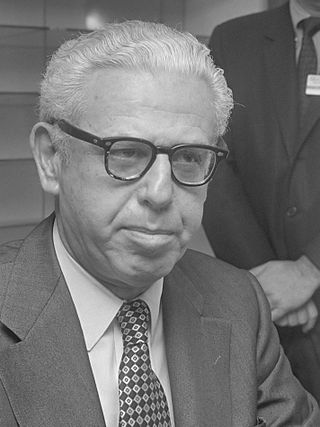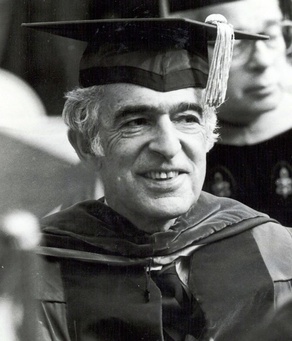
Hugo Lafayette Black was an American lawyer, politician, and jurist who served as a U.S. Senator from Alabama from 1927 to 1937 and as an associate justice of the U.S. Supreme Court from 1937 to 1971. A member of the Democratic Party and a devoted New Dealer, Black endorsed Franklin D. Roosevelt in both the 1932 and 1936 presidential elections.

Abraham Fortas was an American lawyer and jurist who served as an associate justice of the Supreme Court of the United States from 1965 to 1969. Born and raised in Memphis, Tennessee, Fortas graduated from Rhodes College and Yale Law School. He later became a law professor at Yale Law School and then an advisor for the U.S. Securities and Exchange Commission. Fortas worked at the Department of the Interior under President Franklin D. Roosevelt, and was appointed by President Harry S. Truman to delegations that helped set up the United Nations in 1945.

The Supreme Court of the United States is the highest-ranking judicial body in the United States. Established by Article III of the Constitution, the detailed structure of the court was laid down by the 1st United States Congress in 1789. Congress specified the Court's original and appellate jurisdiction, created 13 judicial districts, and fixed the initial size of the Supreme Court. The number of justices on the Supreme Court changed six times before settling at the present total of nine in 1869. As of June 2022, a total of 116 justices have served on the Supreme Court since 1789. Justices have life tenure, and so they serve until they die in office, resign or retire, or are impeached and removed from office.

Felix Frankfurter was an Austrian-born American jurist who served as an Associate Justice of the Supreme Court of the United States from 1939 until 1962, during which he was an advocate of judicial restraint.

William Orville Douglas was an American jurist who served as an associate justice of the Supreme Court of the United States from 1939 to 1975. Douglas was known for his strong progressive and civil libertarian views and is often cited as the U.S. Supreme Court's most liberal justice ever. Nominated by President Franklin D. Roosevelt in 1939, Douglas was confirmed at the age of 40, becoming one of the youngest justices appointed to the court. In 1975, Time called Douglas "the most doctrinaire and committed civil libertarian ever to sit on the court." He is the longest-serving justice in history, having served for 36 years and 209 days.

William Francis Murphy was an American politician, lawyer, and jurist from Michigan. He was a Democrat who was named to the Supreme Court of the United States in 1940 after a political career that included serving as United States Attorney General, 35th governor of Michigan, and Mayor of Detroit. He also served as the last Governor-General of the Philippines and the first High Commissioner to the Philippines.

Arthur Joseph Goldberg was an American statesman and jurist who served as the 9th U.S. Secretary of Labor, an Associate Justice of the Supreme Court of the United States, and the 6th United States Ambassador to the United Nations.

The Warren Court was the period in the history of the Supreme Court of the United States from 1953 to 1969 when Earl Warren served as the chief justice. The Warren Court is often considered the most liberal court in U.S. history.

Henry Jacob Friendly was an American jurist who served as a federal circuit judge on the United States Court of Appeals for the Second Circuit from 1959 to 1986, and as the court's chief judge from 1971 to 1973. Friendly was one of the most prominent U.S. judges of the 20th century, and his opinions are some of the most cited in federal jurisprudence.

The demographics of the Supreme Court of the United States encompass the gender, ethnicity, and religious, geographic, and economic backgrounds of the 116 people who have been appointed and confirmed as justices to the Supreme Court. Some of these characteristics have been raised as an issue since the court was established in 1789. For its first 180 years, justices were almost always white male Protestants of Anglo or Northwestern European descent.

The Burger Court was the period in the history of the Supreme Court of the United States from 1969 to 1986, when Warren E. Burger served as Chief Justice of the United States. Burger succeeded Earl Warren as Chief Justice after Warren's retirement, and served as Chief Justice until his retirement, when William Rehnquist was nominated and confirmed as Burger's replacement. The Burger Court is generally considered to be the last liberal court to date. It has been described as a transitional court, due to its transition from having the liberal rulings of the Warren Court to the conservative rulings of the Rehnquist Court.
Although he was president for less than three years, John F. Kennedy appointed two men to the Supreme Court of the United States: Byron White and Arthur Goldberg. Given the advanced age of Associate Justice Felix Frankfurter at the time of Kennedy's inauguration, speculation abounded over potential Kennedy nominations to the Supreme Court from the start of his presidency.

James Clark McReynolds was an American lawyer and judge from Tennessee who served as United States Attorney General under President Woodrow Wilson and as an associate justice of the Supreme Court of the United States. He served on the Court from 1914 to his retirement in 1941. McReynolds is best known today for his sustained opposition to the domestic programs of President Franklin D. Roosevelt and his personality, which was widely viewed negatively and included documented elements of overt antisemitism and racism.
During his twelve years in office, President Franklin D. Roosevelt appointed eight new members of the Supreme Court of the United States: Associate Justices Hugo Black, Stanley F. Reed, Felix Frankfurter, William O. Douglas, Frank Murphy, James F. Byrnes, Robert H. Jackson, and Wiley Blount Rutledge. Additionally, he elevated sitting Justice Harlan F. Stone to chief justice. Roosevelt's nine nominations filled eight seats on the Supreme Court because Byrnes resigned while Roosevelt was still in office. Roosevelt nominated Rutledge to the seat vacated by Byrnes.

Henry Julian Abraham was a German-born American scholar on the judiciary and constitutional law. He was James Hart Professor of Government Emeritus at the University of Virginia. He was the author of 13 books, most in multiple editions, and more than 100 articles on the U.S. Supreme Court, judicial appointments, judicial process, and civil rights and liberties.

Louis Dembitz Brandeis was an American lawyer who served as an associate justice on the Supreme Court of the United States from 1916 to 1939.

The Stone Court refers to the Supreme Court of the United States from 1941 to 1946, when Harlan F. Stone served as Chief Justice of the United States. Stone succeeded the retiring Charles Evans Hughes in 1941, and served as Chief Justice until his death, at which point Fred Vinson was nominated and confirmed as Stone's replacement. He was the fourth chief justice to have previously served as an associate justice and the second to have done so without a break in tenure. Presiding over the country during World War II, the Stone Court delivered several important war-time rulings, such as in Ex parte Quirin, where it upheld the President's power to try Nazi saboteurs captured on American soil by military tribunals. It also supported the federal government's policy of relocating Japanese Americans into internment camps.

The Vinson Court refers to the Supreme Court of the United States from 1946 to 1953, when Fred M. Vinson served as Chief Justice of the United States. Vinson succeeded Harlan F. Stone as Chief Justice after the latter's death, and Vinson served as Chief Justice until his death, at which point Earl Warren was nominated and confirmed to succeed Vinson.
Woodrow Wilson appointed three Associate Justices to the Supreme Court of the United States, James Clark McReynolds, Louis Brandeis, and John Hessin Clarke.















